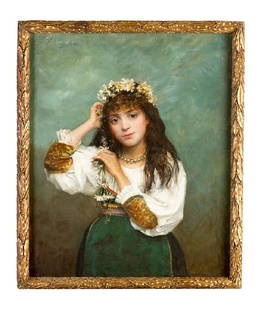
Cuzco School, late seventeenth century.
Similar Sale History
View More Items in Paintings
Related Paintings
More Items in Paintings
View MoreRecommended Art
View More








Item Details
Description
Cuzco School, late seventeenth century.DIEGO QUISPE TITO (Peru, 1611 - 1681), attributed.Virgin with angels.Oil on canvas.Size: 168 x 109 cm.The excellent quality of this painting, especially in the emulation of the brocade and the trimming of the Virgin's mantle, as well as in the cascading fall of the silky hair of amber reflections, the hand of Diego Quispe Tito, one of the most outstanding masters of the Peruvian school of the XVII century, can be appreciated. The sumptuousness of tunics and mantles, in Quispe's Marian representations, is expressed, for example, in the Virgin of Carmen preserved in the Brooklyn Museum, a work that we can relate to the one we are dealing with. In this case, the Virgin appears surrounded by cherubim and seraphim emerging from the golden sky, among cottony clouds. They carry offerings in the form of flowers and monstrances. Following the Spanish baroque model in the representation of the Immaculate Conception, the Virgin rests on a crescent moon. But, in spite of presenting echoes of the Murillo language, the painting in question is developed in a typically autochthonous language, cuzqueño, which Diego Quispe contributed to define.Diego Quispe Tito was a Peruvian painter of Andean origin. He is considered one of the most outstanding members of the Cuzco School. The documentary testimonies regarding his life are scarce, however, it can be said that he began his pictorial work around 1627, date of which dates his first canvas and probably belonged to the indigenous nobility. He established himself as an artist of great prestige in the city of Cusco from the 1660s, when he intensified his production for the temple of San Sebastian. It is from the virtuosity he demonstrates in the painting cycles he produces for this temple that he wins the favor of his most important patrons in Cuzco and Upper Peru, where he regularly sent paintings. In a painting he sent to Potosí in 1667 he signed ""Quispi Tito inga inbentó del año D-1667, edad 56"", a way of highlighting the creative and cultured aspect of his work. He was a follower of Gregorio Gamarra, who in turn was a disciple of father Bernardo Bitti. His painting had two stages. In the first, his painting was characterized by certain traces of Mannerism, while in the second, the influence of Flemish engravings can be seen in his painting. However, he is a painter who is somewhat outside the prevailing style in the city of Cuzco and who ends up developing and imposing a new style to the painting of the region. He implants the use of large landscapes full of flowers and animals that later become characteristic of Cuzco painting."
Buyer's Premium
- 23%
Cuzco School, late seventeenth century.
Estimate €20,000 - €25,000
1 bidder is watching this item.
Get approved to bid.
Shipping & Pickup Options
Item located in Barcelona, barcelona, esOffers In-House Shipping
Payment

TOP





































































